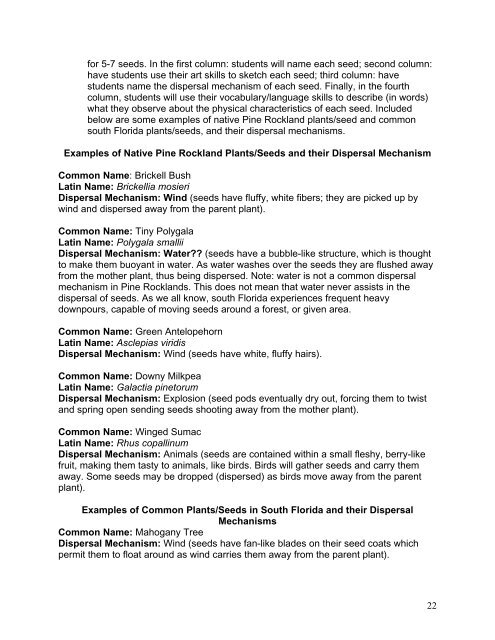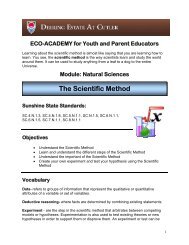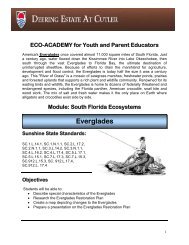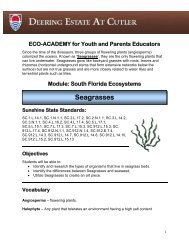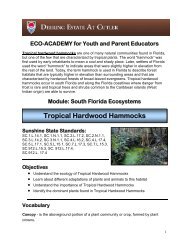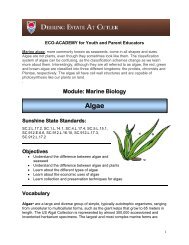Pine Rockland Lesson Plan 2 - Deering Estate at Cutler
Pine Rockland Lesson Plan 2 - Deering Estate at Cutler
Pine Rockland Lesson Plan 2 - Deering Estate at Cutler
Create successful ePaper yourself
Turn your PDF publications into a flip-book with our unique Google optimized e-Paper software.
for 5-7 seeds. In the first column: students will name each seed; second column:<br />
have students use their art skills to sketch each seed; third column: have<br />
students name the dispersal mechanism of each seed. Finally, in the fourth<br />
column, students will use their vocabulary/language skills to describe (in words)<br />
wh<strong>at</strong> they observe about the physical characteristics of each seed. Included<br />
below are some examples of n<strong>at</strong>ive <strong>Pine</strong> <strong>Rockland</strong> plants/seed and common<br />
south Florida plants/seeds, and their dispersal mechanisms.<br />
Examples of N<strong>at</strong>ive <strong>Pine</strong> <strong>Rockland</strong> <strong>Plan</strong>ts/Seeds and their Dispersal Mechanism<br />
Common Name: Brickell Bush<br />
L<strong>at</strong>in Name: Brickellia mosieri<br />
Dispersal Mechanism: Wind (seeds have fluffy, white fibers; they are picked up by<br />
wind and dispersed away from the parent plant).<br />
Common Name: Tiny Polygala<br />
L<strong>at</strong>in Name: Polygala smallii<br />
Dispersal Mechanism: W<strong>at</strong>er?? (seeds have a bubble-like structure, which is thought<br />
to make them buoyant in w<strong>at</strong>er. As w<strong>at</strong>er washes over the seeds they are flushed away<br />
from the mother plant, thus being dispersed. Note: w<strong>at</strong>er is not a common dispersal<br />
mechanism in <strong>Pine</strong> <strong>Rockland</strong>s. This does not mean th<strong>at</strong> w<strong>at</strong>er never assists in the<br />
dispersal of seeds. As we all know, south Florida experiences frequent heavy<br />
downpours, capable of moving seeds around a forest, or given area.<br />
Common Name: Green Antelopehorn<br />
L<strong>at</strong>in Name: Asclepias viridis<br />
Dispersal Mechanism: Wind (seeds have white, fluffy hairs).<br />
Common Name: Downy Milkpea<br />
L<strong>at</strong>in Name: Galactia pinetorum<br />
Dispersal Mechanism: Explosion (seed pods eventually dry out, forcing them to twist<br />
and spring open sending seeds shooting away from the mother plant).<br />
Common Name: Winged Sumac<br />
L<strong>at</strong>in Name: Rhus copallinum<br />
Dispersal Mechanism: Animals (seeds are contained within a small fleshy, berry-like<br />
fruit, making them tasty to animals, like birds. Birds will g<strong>at</strong>her seeds and carry them<br />
away. Some seeds may be dropped (dispersed) as birds move away from the parent<br />
plant).<br />
Examples of Common <strong>Plan</strong>ts/Seeds in South Florida and their Dispersal<br />
Mechanisms<br />
Common Name: Mahogany Tree<br />
Dispersal Mechanism: Wind (seeds have fan-like blades on their seed co<strong>at</strong>s which<br />
permit them to flo<strong>at</strong> around as wind carries them away from the parent plant).<br />
22


